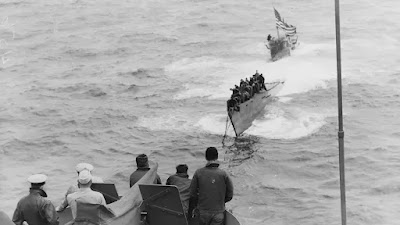23 June 2024: June winds down with oppressive heat and strong squalls troubling the U.S. Northeast. I would say "global warming" except it's summer and it often gets hot during the summer.... and some summers are hotter than others! So, maybe or maybe not. But just to be safe, keep driving EV cars and don't run your air conditioner! I am astonished to reveal that Maritime Maunder has surpassed 200,000 readers with the last post. Truly amazing as we close in on the conclusion (August) of our 10th year and possibly begin number 11!
As a matter of interest, we have heard from a couple of you that we focus too much on the discovery and recovery of ship wrecks and maybe we should offer some other type of maritime stories that might be of interest. So, from Stars and Stripes, the following on the S.S. United States:
~~~~~~~~~~~~~~~
PHILADELPHIA — The SS United States, a historic ship that still holds the transatlantic speed record it set more than 70 years ago, must leave its berth on the Delaware River in Philadelphia by Sept. 12, a federal judge says. The decision issued Friday by U.S. District Judge Anita Brody culminated a years-old rent dispute between the conservancy that oversees the 1,000-foot ocean liner and its landlord, Penn Warehousing. It stemmed from an August 2021 decision by Penn Warehousing to double the ship’s daily dockage to $1,700, an increase the conservancy refused to accept. When the conservancy continued to pay its previous rate, set in 2011, Penn Warehousing terminated the lease in March 2022.

In her berth on Philadelphia waterfront
After much legal wrangling, Brody held a bench trial in January but also
encouraged the two sides to reach a settlement instead of leaving it up to her.
The judge ultimately ruled that the conservancy’s failure to pay the new rate
did not amount to a contract breach or entitle Penn Warehousing to damages. But
she also ruled that under Pennsylvania contract law, the berthing agreement is
terminable at will with reasonable notice, which Penn Warehousing had issued in
March 2022. “The judge’s decision gives us a very limited window to find a new
home for the SS United States and raise the resources necessary to move the
ship and keep her safe,” Susan Gibbs, conservancy president and granddaughter
of the ship’s designer, told The Philadelphia Inquirer. Besides finding a new
home, the conservancy also must obtain funds for insurance, tugs, surveys and
dock preparations for a move. “The best hope of everyone involved was that the
conservancy could successfully repurpose the ship,” said Craig Mills, an
attorney for Penn Warehousing. “But after decades of decay and delay, it is
time to acknowledge the unavoidable and return Pier 82 to productive commercial
service.”
Christened in 1952, the SS United States was once considered a beacon of American engineering, doubling as a military vessel that could carry thousands of troops. On its maiden voyage in 1952, it shattered the transatlantic speed record in both directions, when it reached an average speed of 36 knots, or just over 41 mph, The Associated Press reported from aboard the ship. On that voyage, the ship crossed the Atlantic in three days, 10 hours and 40 minutes, besting the RMS Queen Mary’s time by 10 hours. To this day, the SS United States holds the transatlantic speed record for an ocean liner.
 |
| Leaving NY Harbor for Europe 3 July 1952 Maiden Voyage |
It became a reserve ship in 1969 and later bounced to various private owners who hoped to redevelop it but eventually found their plans to be too expensive or poorly timed. It has loomed for years on south Philadelphia’s Delaware waterfront.
~~~~~~~~~~~~~~~~~~~~~
So, no shipwrecks or recovery this time - and obviously there will be more to this sad story going forward. We surely hope the conservancy can generate enough funding to save this historic vessel. Maybe a hotel or fancy restaurant - or both! Similar concept to the SS Queen Mary in Long Beach Calif! [ed: Wow! 200K readers! Hard to believe!]
Until next time,
Fair Winds,
Old Salt


